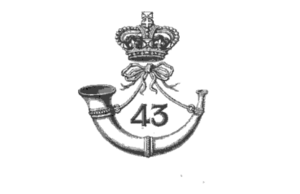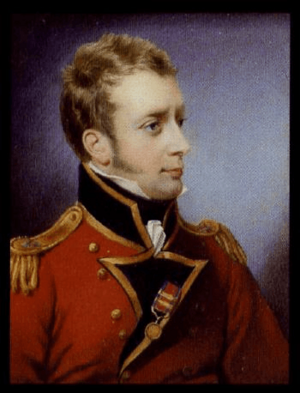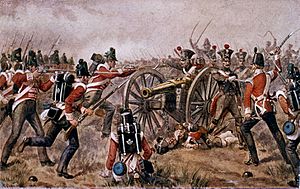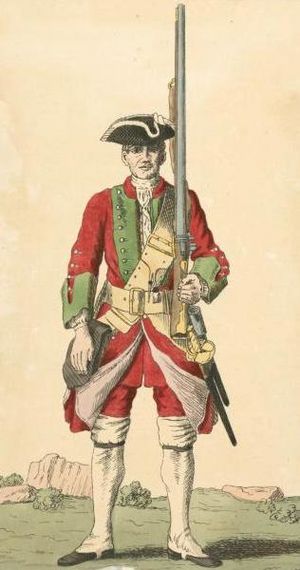43rd (Monmouthshire) Regiment of Foot facts for kids
Quick facts for kids 43rd (Monmouthshire) Regiment of Foot |
|
|---|---|

Badge of the 43rd (Monmouthshire) Regiment of Foot
|
|
| Active | 1741–1881 |
| Country | |
| Branch | |
| Type | Infantry |
| Size | One battalion (two battalions 1804–1817) |
| Garrison/HQ | Copthorne Barracks, Shrewsbury |
| Engagements | Seven Years War American War of Independence Peninsular War Battle of New Orleans Indian Mutiny New Zealand Wars |
The 43rd (Monmouthshire) Regiment of Foot was a famous infantry (foot soldier) regiment in the British Army. It was started in 1741. Later, in 1881, it joined with another regiment, the 52nd (Oxfordshire) Regiment of Foot. Together, they became the Oxfordshire Light Infantry. This new group then changed its name to the Oxfordshire and Buckinghamshire Light Infantry in 1908.
Contents
History of the 43rd Regiment

Starting the Regiment and the Seven Years War
The regiment began in 1741 in Winchester. It was first called Thomas Fowke's Regiment of Foot, after its leader, Colonel Thomas Fowke. Their first job was to guard Menorca in 1742. The regiment's number changed a few times, finally becoming the 43rd Regiment of Foot in 1751.
In 1757, the 43rd sailed to North America. They helped defend the British colonies during the French and Indian War. This war was part of a bigger conflict called the Seven Years' War. In 1759, the 43rd joined General Wolfe's army and helped capture Quebec. This was their first "battle honour," a special award for bravery in battle.
After that, they fought in the West Indies. In 1762, they helped capture Martinique and Saint Lucia from the French. They also helped take Havana from the Spanish.
Fighting in the American War of Independence
The regiment returned to North America in 1774 and stayed there for the entire American War of Independence. The 43rd joined the 52nd Regiment in Boston in 1774. Special companies from the 43rd, called Grenadiers and Light Infantry, fought in the Battles of Lexington and Concord.
At the Battle of Bunker Hill, the regiment was part of the attack force. They had to charge up a heavily defended hill. After the Siege of Boston, the regiment moved to Halifax. A year later, they sailed to Long Island and fought in the Battle of Long Island.
They also fought in the Battle of Rhode Island in November 1776. Soon after, they went back to New York. There, they took part in the Battle of Fort Washington and the Battle of Fort Lee.
In 1781, the regiment moved back to New York City. They were part of the troops guarding the city. Later that year, they joined Brigadier General Benedict Arnold in Virginia and fought in the Battle of Green Spring.
The regiment then arrived in Yorktown. They were there during the Siege of Yorktown later that year.
In 1782, regiments were given county names. The 43rd became the 43rd (Monmouthshire) Regiment of Foot. In 1794, they went back to the West Indies. They captured Martinique and Saint Lucia again. However, they were defeated at Guadeloupe by a much larger French army.
Becoming Light Infantry
In 1803, the 43rd, 52nd, and 95th Rifles became the first "Light Infantry" units. They formed the Light Brigade at Shorncliffe. Their leader was Major-General John Moore. The 43rd was renamed the 43rd (Monmouthshire) Regiment of Foot (Light Infantry). In 1807, the 43rd helped capture Copenhagen and the Danish fleet.
The Peninsular War

In August 1808, the 43rd fought in the Battle of Vimeiro during the Peninsular War. This battle helped push Napoleon's forces out of Portugal. In January 1809, they took part in a difficult retreat to Corunna. They were famous for protecting the army's rear as they left Spain.
In May 1809, the 43rd sailed to Portugal to join Sir Arthur Wellesley's army. They marched 250 miles from Lisbon to Talavera in just 26 hours. This was during the hottest time of year! The battle was won before they arrived, but a company of the 43rd had already fought there.
In 1810, the 43rd was part of the Light Division. They fought in many battles, including the crossing of the Côa in July 1810, the Battle of Bussaco in September 1810, and the Battle of Sabugal in April 1811.
The 43rd also fought at the Battle of Fuentes de Oñoro in May 1811. They helped attack the fortress of Ciudad Rodrigo in January 1812. During the Siege of Badajoz in April 1812, the 43rd lost many soldiers while storming the enemy's defenses.
They continued to fight in Spain at the Battle of Salamanca in July 1812 and the Battle of Vitoria in June 1813. Then, they chased the French army into France. They saw action at the Battle of Nivelle in November 1813, the Battle of the Nive in December 1813, and the Battle of Toulouse in April 1814. After the Peninsular War ended in 1814, the 43rd returned to England.
Battle of New Orleans and Beyond
The 43rd went back to America in 1814. They were part of a force that was defeated at the Battle of New Orleans in 1815. After this, the regiment returned to Europe. They arrived in Belgium too late to fight in the Battle of Waterloo in June 1815. However, some 43rd officers were there, working for the Duke of Wellington. The regiment stayed in France as part of the army of occupation until November 1818.
Service in Canada (1836–1846)
The regiment served in Ireland from 1819 to 1823, then in Gibraltar from 1823 to 1830. After some time in England, the 43rd returned to Canada in 1836. They helped put down the Rebellions of 1837.
In December 1837, in very bad weather, the regiment marched 370 miles from Fredericton to Quebec. They crossed forests, frozen rivers, and mountains in just 18 days! This amazing march was widely praised, even by the Duke of Wellington. The regiment left Canada for England in 1846.
Southern Africa (1851–1853)
The 43rd was sent to South Africa in 1851 to fight in the Eighth Xhosa War. In 1852, some soldiers from the regiment were on the ship HMS Birkenhead. The ship hit rocks and began to sink. The soldiers showed incredible bravery and discipline. They let the women and children get into the lifeboats first. They stood firm on deck, even when told that jumping into the water might upset the lifeboats and endanger the civilians. Many men drowned, but their courage was praised around the world. The King of Prussia even ordered the story to be read to his own army as an example of duty.
The Indian Mutiny
The 43rd moved from South Africa to India in 1854. They helped stop the Indian Mutiny from 1857 to 1859. During this time, the regiment marched 1,300 miles in six months! They fought many battles along the way. The regiment also won its first Victoria Cross, awarded to Henry Addison in 1859 for his bravery.
New Zealand Wars
In September 1863, the 43rd left India to fight in the New Zealand Wars. They led the attack at Gate Pa in April 1864. They also took part in the attack on the fort at Te Ranga in June 1864. Frederick Augustus Smith received the Victoria Cross for his bravery during an attack on a Maori trench. The regiment returned to England in February 1866.
Later Years and Amalgamation
For the next 15 years, the regiment was mostly stationed abroad. They helped stop a rebellion by the Moplahs in Southern India in 1873.
In 1881, as part of army reforms, the 43rd joined with the 52nd (Oxfordshire) Regiment of Foot (Light Infantry). They formed the 1st and 2nd battalions of the Oxfordshire Light Infantry. This regiment later became the Oxfordshire and Buckinghamshire Light Infantry in 1908.
Battle Honours
Battle honours are special awards given to regiments for their bravery in important battles. The 43rd Regiment earned many:
- Quebec 1759
- Martinique 1762
- Havannah
- Peninsular War: Vimiera, Corunna, Busaco, Fuentes d'Onor, Ciudad Rodrigo, Badajoz, Salamanca, Vittoria, Nivelle, Nive, Peninsula
- Napoleonic Wars: Toulouse
- New Zealand
- South Africa 1851-2-3
- Martinique 1794
- Pyrenees
Victoria Cross Recipients
The VC is the highest award for bravery in the British military.
- Henry Addison received the VC in 1859 for his actions during the Indian Mutiny.
- Frederick Augustus Smith received the VC in 1864 for his bravery in the New Zealand Land Wars.
Colonels of the Regiment
The Colonels were the most senior officers of the regiment. Some notable ones included:
- 1741: Lt-Gen. Thomas Fowke
- 1746–1761: Lt-Gen. James Kennedy
- 1766–1792: Gen. Hon. George Carey
- 1809–1839: Gen Rt Hon Sir John Cradock, 1st Baron Howden
- 1844–1850: Lt-Gen. Hon. Sir Hercules Robert Pakenham
- 1850–1865: Gen. Sir James Fergusson
- 1869–1881: Gen. Hon. Sir Augustus Almeric Spencer
See also
- British Army during the Napoleonic Wars
- Sable Island - where some officers and men of the Regiment were shipwrecked in 1760




